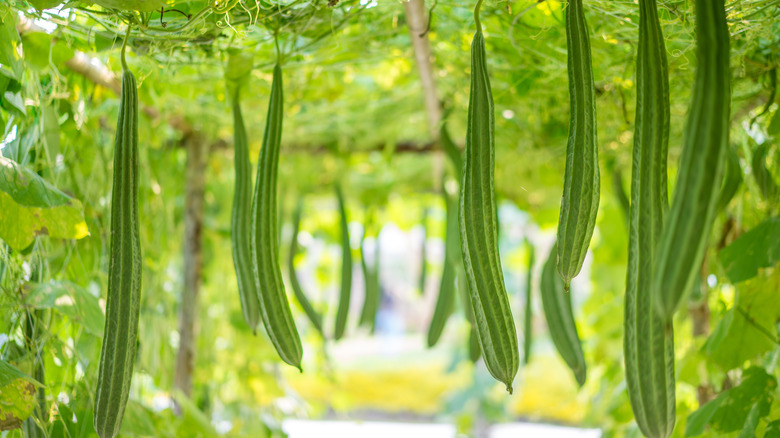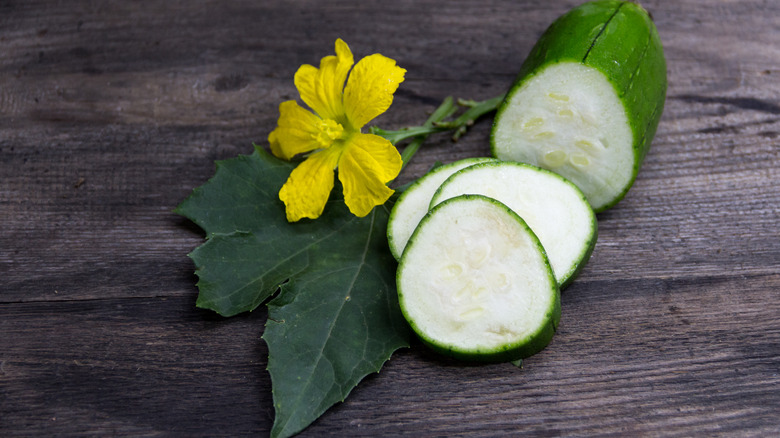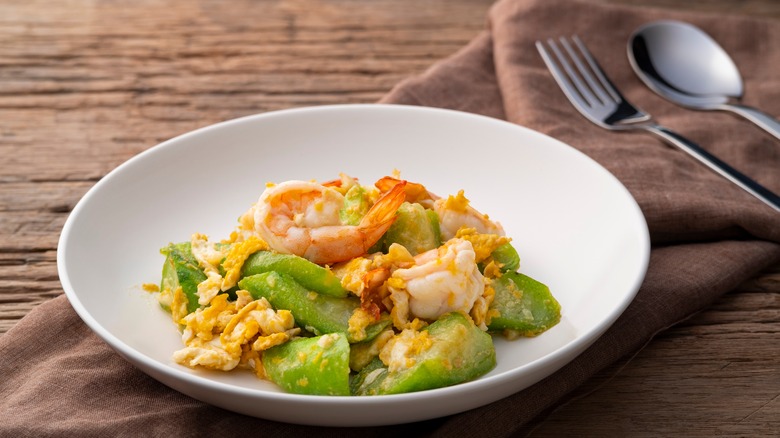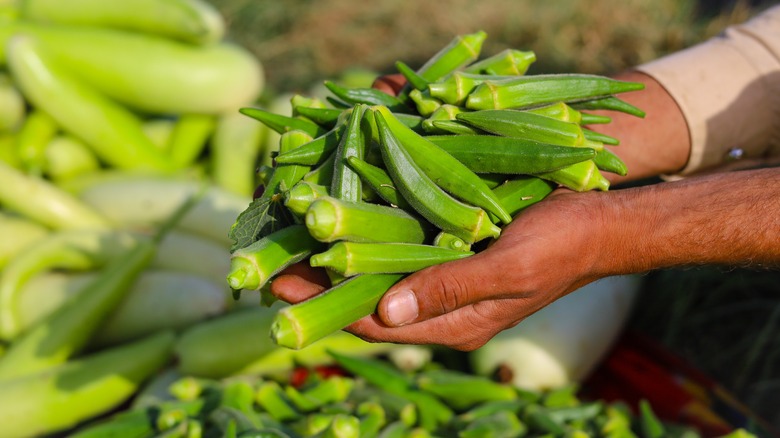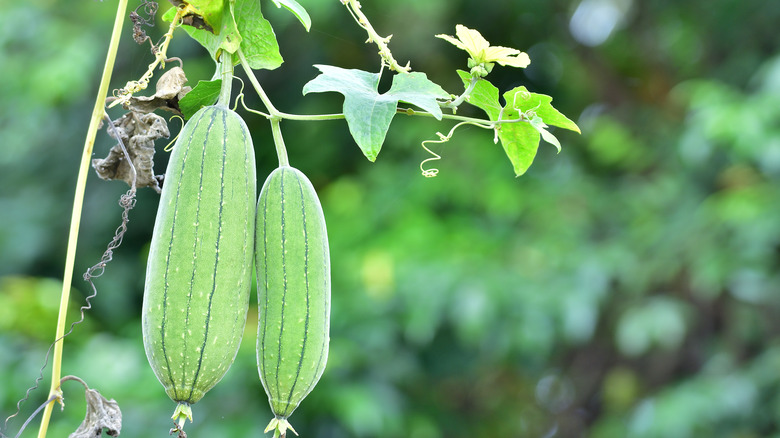What Is Angled Luffa And How Do You Eat It?
The humble luffa is a staple of showers and dining tables alike. Throughout history, the vegetable has been used as an ingredient, sponge, and even shoes, according to the National Garden Bureau. Among the many varieties of luffa cultivated around the world is the angled luffa — or loofah — which, like other luffas, is part of the gourd family (via University of Florida, Institute of Food and Agricultural Sciences).
Angled luffa goes by several names, which could potentially make it confusing to shop for and find recipes featuring if you're not already familiar with the ingredient; An article published in the International Journal of Current Pharmaceutical Review and Research shares that among angled luffa's many aliases are Chinese okra, silk gourd, and ridge gourd. In addition to its culinary uses, angled luffa is believed to have medicinal properties. In Ayurveda (a traditional medicine practice that John Hopkins University explains believes disease can be cured naturally by balancing "body, mind, spirit, and the environment") angled luffa is used to treat diseases like anemia, tumors, and also as a diuretic. But no matter if you're looking for health benefits or just a tasty meal, there are a few things you should know about angled luffa.
What is angled luffa?
Angled luffa's numerous monikers aside, the gourd is known more precisely by its botanical name luffa acutangula, according to the University of Florida, Institute of Food and Agricultural Science. A member of the Cucurbitaceae plant family, the Ontario Ministry of Agriculture, Food & Rural Affairs explains angled luffa is closely related to other vegetables you're likely familiar with, like cucumbers and squash.
A climbing vine originating from South Asia, the CABI Compendium shares that angled luffa is widely grown in areas with tropical and subtropical climates, including West Africa, Japan, and Brazil. Angled luffa is an annual plant that produces yellow flowers and is capable of growing vines roughly five to 10 meters in length. Peak season for the angled luffa's vegetable is in the summer, and each gourd typically grows to be about 30 to 40 centimeters long (via Specialty Produce).
The nutrition and possible health benefits of angled luffa
An article published in the Journal of Food Science and Technology reports angled luffa contains charantin and peptide, two compounds known to help regulate insulin levels, and a variety of nutrients like vitamin C and riboflavin. Its ridged skin contains high amounts of fiber, which aids digestion, while its seeds contain amino acids, iron, and magnesium.
Angled luffa may also be effective at treating liver diseases, as explained in a study published in Frontiers in Pharmacology. It may also help lower glucose levels, inhibit cancer cell growth, and ease inflammation. However, the same study points out that more clinical research needs to be done, as these tests were not conducted on humans. That said, angled luffa is frequently used in Indian home remedies for everything from treating snake bites, according to a study published in Journal of Medical Plants Studies, to dysentery and leprosy (via International Journal of Current Pharmaceutical Review and Research).
Preparing and cooking angled luffa
Westchester Magazine shares that angled luffa has a soft texture and a somewhat sweet taste, similar to zucchini. If you're buying angled luffa from an Asian grocer or your local farmers market, make sure to choose one that is still young and soft, as the vegetable gets bitter as it ages (via Crystal Valley Specialty Produce).
Stir-fried, steamed, deep-fried, or simmered in soup, angled luffa can be cooked virtually any way you'd like. You can also eat the vegetable raw, adding slices to a salad, as suggested by Our Permaculture Life. To start, either peel the luffa or leave the skin on, then cut your vegetable into chunks and add it to your recipe of choice. If you're cooking the gourd, be sure not to cut it too thin, as Oh Snap! Let's Eat! explains it can become unpleasantly soft.
A common ingredient throughout Asia, there are a few standard dishes that make use of the veggie. In Thailand, there is an egg and angled luffa stir-fry called buab pud kai, according to Thai Table, while you'll find a similar dish named cha roroang in Cambodia (via Angkor Chef). Popular soups featuring angled luffa include the Philippines' miswa at patola, per Kawaling Pinoy, and Cambodian canh mướp thịt băm, as shared by Vicky Pham.
How angled luffa differs from okra
Though angled luffa is sometimes called Chinese okra, it is a member of the Cucurbitaceae family, as stated above, not the Malvaceae family, which the Integrated Taxonomic Information System explains okra is part of. This means angled luffa is actually more closely related to fruits and vegetables like watermelon, squash, and cucumber than its occasional namesake (via New Phytologist).
In addition to not sharing a plant family, okra and angled luffa have few similarities in terms of flavor and texture, meaning they are not a great substitute for one another in recipes. Compared to angled luffa, okra is shorter — about four inches or so in length, per Crystal Valley Specialty Produce. Okra has a slightly fuzzy exterior and the interior is described as "spongy." The green vegetable is known for its slimy texture, which some people find unappealing, and is often served fried or in gumbo, where Sustainable Food Center explains its mucous-like properties are less intense due to the cooking methods used. Okra can also be eaten raw, pickled, or sauteed.
Angled luffa and smooth luffa compared
Unsurprisingly, the vegetable that angled luffa is most similar to is the smooth luffa. Smooth luffa, also known as sponge luffa, goes by the scientific names luffa aegyptiaca or luffa cylindrica (via Integrated Taxonomic Information System). Both the smooth and angled luffa enjoy growing conditions with lots of sunlight and moist soil, according to Epic Gardening.
Like its angled sibling, the smooth luffa is commonly added to stir-fry dishes and soups, with Vicky Pham sharing it is also used in Vietnamese canh mướp thịt băm. In fact, many recipes make no distinction between angled and smooth luffa varieties, so generally, you can use whichever you're most easily able to source.
If you can use smooth or angled luffa interchangeably in cooking, is there any practival difference between the two? According to This NZ Life, it really comes down to what you want to use your luffa for. Because smooth luffa's fibers are easier to extract compared to angled luffa, it's the variety of choice for sponge making. So if you're growing your own and would like to DIY your next sponge, opt for the smooth loofa, but if you're trying to make a stir-fry you really can't go wrong with either, it just comes down to personal preference.
